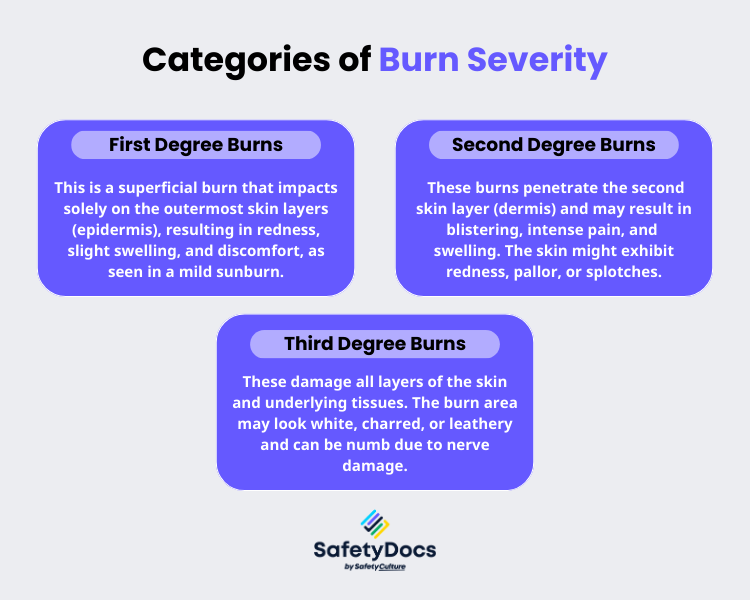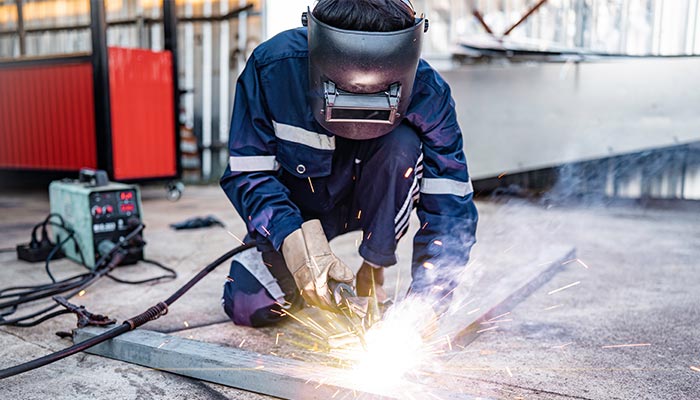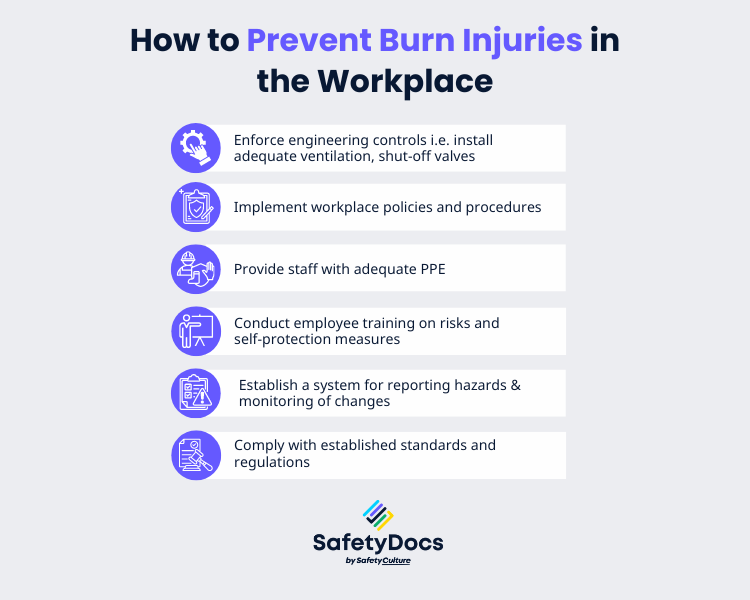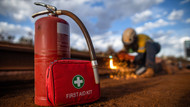Every June, Burns Awareness Month focuses on raising awareness about burn injuries and their prevention. Spearheaded by Kidsafe, Australia's foremost child injury prevention organisation, this campaign partners with the Australian and New Zealand Burns Association (ANZBA) to educate the public on burn prevention and first aid.
Safe Work Australia reports that between 2021 and 22, burns impacted 1,100 workers, accounting for 1.4% of all occupational injuries. Suppose we are talking about occupational injuries overall. The 1.4% may not seem significant, but this figure represents hundreds of workers' lives affected by preventable incidents.WHO has also reported that it results in an estimated 180,000 deaths annually.
Is this matter serious enough to deserve attention? Absolutely.
This blog post will discuss workplace burns and how to prevent them. We will cover the different types of burns, risk factors, consequences, and strategies for burn prevention. Additionally, we will provide tips on emergency response and first aid for burns and share additional resources to help employers create a safer workplace.
What is a Burn?
A burn is a form of injury to the skin or other tissues resulting from heat, radiation, electricity, chemicals, friction, or contact with hot objects. Depending on the type and severity, burns can range from minor discomfort to life-threatening injuries.
Severity
Burns are classified into three primary categories based on severity:
- First Degree Burns: This is a superficial burn that impacts solely on the outermost skin layers (epidermis), resulting in redness, slight swelling, and discomfort, as seen in a mild sunburn.
- Second Degree Burns: These burns penetrate the second skin layer (dermis) and may result in blistering, intense pain, and swelling. The skin might exhibit redness, pallor, or splotches.
- Third Degree Burns: These damage all layers of the skin and underlying tissues. The burn area may look white, charred, or leathery and can be numb due to nerve damage.

Types
Burns can be categorised according to their underlying cause:
Thermal Burns
Thermal (heat) burns are the most prevalent type of burns encountered in the workplace. They result from contact with flames, very hot water, hot surfaces, steam, and other sources of extreme heat, such as scalding liquids and steam. Some causes in the workplace include:
- Accidents with machinery or equipment that generates heat, such as ovens, stoves, grills, and welding tools
- Exposure to fire or explosions
- Contact with hot objects, such as metal surfaces, liquids, and steam pipes
Electrical
The next common type leading cause of burn is electrical, caused by a current getting through the body and causing external and internal injuries. Common causes in the workplace include:
- Contact with exposed wires or defective electrical equipment
- Faulty wiring in buildings
- Accidents involving high-voltage power lines and electrical systems
Chemical
A chemical burn occurs when skin or other tissues come into contact with corrosive substances such as acids, alkalis, or solvents. These burns can cause severe damage, like deep burns, depending on the type and concentration of the chemical, as well as the duration of exposure. Chemical burns can happen in the workplace when:
- Handling and using hazardous chemicals
- Spills and splashes of corrosive substances on the skin
- Mixing incompatible chemicals
Radiation
Radiation burns result from exposure to different types of radiation like ultraviolet rays, X-rays, and gamma rays.These burns are less common in the workplace but can happen when working with radioactive materials or equipment. Occupational sources may include:
- Welding arcs
- Medical or industrial X-ray equipment
- Radioactive materials
Risk Factors for Burn Injuries
Specific industries, job positions, and tasks pose a higher risk of burn injuries because of the unique work environments and activities involved. Here are some of the key sectors and roles where burn risks are elevated:
High-Risk Industries
The top Australian industries for work-related burn injuries include:
- Accommodation and Food Services account for 5.6% of all work-related injuries
- Agriculture, Forestry, and Fishing, with 5.4% of work-related injuries
- Transport, Postal, and Warehousing, representing 5.1% of work-related injuries
Other high-risk industries include:
- Construction: Workers in this industry are frequently exposed to heat and have a high risk of burns from handling hot materials, working with welding equipment, or being near open flames.
- Manufacturing: People who work in manufacturing plants also face higher risks due to machinery that generates heat and chemicals used in production processes.
- Hospitality: Employees in restaurants and commercial kitchens are prone to thermal burns from cooking equipment, scalding liquids, and steam.
- Foodservice: Working with open flames, hot liquids, and cooking equipment puts food service workers at a higher risk of burns.
- Healthcare: Healthcare professionals are exposed to various hazards that can cause burns, including chemicals, radiation, and infectious agents.
- Plant Operations: Power plant workers and others working with high-voltage equipment are at risk of electrical burns. In contrast, chemical plants pose a risk for chemical burns.
- Welding: Welders are at risk of thermal and radiation burns from working with high temperatures and exposure to welding arcs.
- Offshore Drilling: The potential for fires and explosions in tight quarters and exposure to corrosive chemicals puts offshore workers at an elevated risk for burns.

High-Risk Job Roles
Aside from specific industries, certain job roles within those sectors also carry elevated risks for burn injuries. These include:
- Food service workers such as cooks, chefs, and kitchen staff
- Nurses and healthcare professionals
- Electricians and electrical workers
- Plumbers and pipefitters
- Welders and metalworkers
- Industrial machine operators
Preventing Burn Injuries in the Workplace
Burn injuries can have severe consequences, but many are preventable with the proper safety measures. Here are some key strategies for preventing burn injuries in the workplace:
Engineering Controls
Engineering controls involve physically changing the workplace environment to eliminate or reduce potential hazards. Burns can be prevented by implementing the following engineering controls:
- Install Safety Devices: Use engineering controls like automatic shut-off valves, temperature controls, and emergency stop buttons on machinery.
- Ventilation Systems: Install adequate ventilation systems in areas where chemicals are used to reduce the risk of inhalation and chemical burns.
- Safety Guards: Use safety guards and shields on equipment to protect workers from exposure to heat or chemicals.
Administrative Controls
Administrative controls refer to measures that employers put in place to prevent burns, such as implementing workplace policies and procedures. Some key administrative controls include:
- Regularly training employees on burn hazards, proper use of protective equipment, and emergency procedures
- Developing safe work practices for handling hazardous chemicals or working near heat sources
- Establishing a system for reporting potential hazards and addressing them promptly
Personal Protective Equipment (PPE)
PPE refers to specialised gear designed to protect workers from hazards in the workplace. PPE can help prevent burns by providing a physical barrier between workers and potential sources of injury. Some examples of PPE that can help prevent burns include:
- Flame-resistant clothing for workers in hot environments or those working with open flames
- Gloves, aprons, and goggles for protection against chemical burns
- Respirators for workers exposed to harmful fumes or smoke from fires or explosions
Employee Training and Education
Employee training is crucial in preventing burn injuries. Employers must train workers on job-related risks and self-protection measures. Training should also cover the following:
- Safety Training: Provide comprehensive training on the proper handling of hazardous materials, use of equipment, and emergency procedures.
- Regular Refresher Courses: Conduct periodic refresher courses to keep employees' knowledge of best safety practices up to date.
- First Aid Training: Train workers in basic first aid procedures, including how to treat burns until professional medical help is available.
Reporting and Monitoring
Employers should establish a system for reporting potential hazards and monitoring the workplace for changes that could increase the risk of serious burns elsewhere. This can involve conducting regular inspections and addressing any safety concerns promptly. It also includes:
- Incident Reporting: Encourage prompt reporting of all burn incidents, regardless of severity, to understand their causes and prevent recurrence.
- Data Analysis: Analyse incident reports to identify patterns and implement targeted improvements.
Safety Culture
A safety culture promotes a secure work environment where employees can report hazards without fear of reprisal. Employers should promote safety as a top priority. This can involve:
- Safety Committees and representatives from different departments
- Regular meetings or toolbox talks to consult on potential hazards and share best practices
- Rewarding employees for actively promoting safety or coming up with innovative solutions to prevent burn injuries.
These measures safeguard employees while enhancing productivity and strengthening the overall success of an organisation.
Compliance with Regulations
Complying with established standards and regulations is crucial for preventing burn injuries in the workplace. These guidelines provide a framework for maintaining a safe working environment and ensure that safety measures are consistently applied. Some of the most relevant regulations and standards for burn prevention in Australian workplaces are:
- AS 1851 - Standard for proper maintenance of fire protection systems and equipment.
- AS 1670 - Standard for the design, installation, and maintenance of fire detection and alarm systems.
- AS/NZS 3000 or the Australian / New Zealand Wiring Rules- Standards for electrical installations in Australia and New Zealand.
- AS 1905 - Standard for the design and installation of portable fire-resistant doorset.

Emergency Response and First Aid
Burn injuries can sometimes be unavoidable despite the best prevention measures. Therefore, workplaces must be well-prepared to respond effectively if such injuries occur. Here are key steps and considerations for emergency response and first aid:
1. Immediate Actions
Act immediately when a burn injury occurs. The faster the response, the better the outcome. In the case of a burn injury, here are some immediate actions that should be taken:
- Move the injured person to a safe area away from further injury risk.
- Remove any clothing or jewellery that has come into contact with the burn.
- Remove the source of the burn. This might include turning off electricity, removing the person from the heat source, or rinsing away chemicals.
2. First Aid Steps
The following first aid steps can help to prevent infection and reduce the severity of a burn injury:
- Assess the Situation: Evaluate the severity of the burn. Call emergency services immediately if it is a severe burn (third-degree or covering a large area).
- Cool the Burn:
- Cool the burn with running cool water for at least 10-20 minutes for thermal burns. Do not use ice, as it can cause further tissue damage.
- For chemical burns, flush the affected area with running water for 15-20 minutes to dilute the chemical.
- Remove Contaminated Clothing: Carefully remove any clothing or jewellery near the burn site. Do not peel off anything stuck to the burned skin.
- Cover the Burn: Cover the burn with sterile, non-adhesive bandages or clean cloths to protect it from infection.
- Avoid Home Remedies: Avoid using ointments, butter, or home remedies on burns as they may cause infection and disrupt medical treatment.
- Elevate the Burned Area: If possible, elevate the burned area above the level of the heart to reduce swelling and pain.
- Monitor for Shock: Look for signs of shock, such as fainting, pale complexion, or rapid breathing, and treat accordingly by keeping the person warm and lying down.
3. Emergency Equipment
You must be ready to provide emergency care and have the necessary equipment. This includes:
- First Aid Kits: Ensure that first aid kits are well-stocked and easily accessible in multiple locations throughout the workplace.
- Emergency Showers and Eyewash Stations: Regularly maintain and ensure accessibility to emergency showers and eyewash stations, especially in areas where chemicals are used.
- Fire Extinguishers and Blankets: Keep fire extinguishers and fire blankets readily available and ensure employees are trained to use them.
4. Employee Training
Another crucial aspect of emergency response is providing proper training to employees. Every workplace must require the following:
- Regular Drills: Conduct regular emergency drills to ensure all employees know the steps to take in the event of a burn injury.
- First Aid Certification: Encourage or require key staff members to obtain first aid certification, emphasising burn treatment.
- Clear Communication Channels: Establish clear communication channels for reporting burn injuries and seeking help swiftly.
5. Emergency Response Plans
Every workplace should have a comprehensive emergency response plan to guide employees in handling burn injuries. This plan should include:
- Designated Response Team
- Emergency Contacts
- Emergency Procedures
- Evacuation Plans
6. Post-Incident Protocol
Following up with proper post-incident protocol is essential if a burn injury occurs. This will prevent future injuries and ensure the injured worker gets adequate care. This may include:
- Documenting the incident thoroughly, including details about how the burn occurred, the response actions taken, and any immediate medical interventions.
- Analysing the incident to identify safety protocol gaps or emergency response gaps and implement improvements to prevent future occurrences.
- Providing support and resources for the injured employee, such as medical care and accommodations for their recovery.
- Conducting follow-up evaluations to ensure proper healing and identify any long-term effects or concerns.
- Reviewing and updating safety protocols and training based on the incident to prevent similar injuries in the future.
Prevent and Manage Burn Injuries Effectively with SafetyDocs
Minimise the consequences of workplace burns through well-defined plans and effective response strategies using SafetyDocs by SafetyCulture. We offer comprehensive resources and documents to help businesses effectively prevent and manage burn injuries. Our customisable templates for safety plans, training materials, and emergency preparedness protocols make it easy for companies to comply with occupational safety standards and regulations.
Here are some resources or templates that can help businesses prevent workplace burns:
- Fire Prevention and Safety Safe Operating Procedure
- Chemicals Safe Operating Procedure
- Prescribed Burns Safe Work Method Statement
- Emergency Response Procedure - Fire
With SafetyDocs, you can avoid potential hazards and protect your employees from burn injuries. Download our resources and improve your emergency preparedness today!
Our team of experts is dedicated to providing accurate and informative content. Craig Cruickshank, our senior HSEQ advisor at SafetyDocs by SafetyCulture has reviewed this blog post to ensure the highest level of quality.
Learn more about Craig's work on LinkedIn for more industry insights.
Available for instant download and supplied in fully editable MS Word format for use in your business.
Please note that the above information is provided as a comment only and should not be relied on as professional, legal or financial advice.
Share This Article
